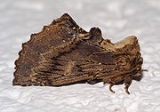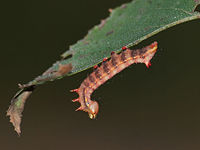
Coxcomb Prominent
Encyclopedia
The Coxcomb Prominent is a moth
of the family Notodontidae
. It is a common species throughout Europe
.
 This species has brown forewings, varying considerably in tone, with indistinct darker markings. The hindwings are buffish with a black spot at the tornus
This species has brown forewings, varying considerably in tone, with indistinct darker markings. The hindwings are buffish with a black spot at the tornus
. At rest, the species has a very distinctive profile with tufts of hairs protruding upwards from the thorax
and the hind edge of the forewings (this latter feature shared with other prominents). The margins of the forewings are also wavy. This rather "lumpy" appearance has led to the rather fanciful comparison to the comb on a cock's
head. Two broods are produced each year with adults on the wing in May and June and again in August and September . This moth flies at night and is attracted to light.
The larva
is green or brown with a yellow stripe down each side and two red humps at the rear end. It is polyphagous and feeds on a wide variety of deciduous
tree
s and shrub
s (see list below). The species overwinters as a pupa
.
Moth
A moth is an insect closely related to the butterfly, both being of the order Lepidoptera. Moths form the majority of this order; there are thought to be 150,000 to 250,000 different species of moth , with thousands of species yet to be described...
of the family Notodontidae
Notodontidae
Notodontidae is a family of moths with approximately 3,500 known species. Moths of this family are found in all parts of the world, but they are most concentrated in tropical areas, especially in the New World...
. It is a common species throughout Europe
Europe
Europe is, by convention, one of the world's seven continents. Comprising the westernmost peninsula of Eurasia, Europe is generally 'divided' from Asia to its east by the watershed divides of the Ural and Caucasus Mountains, the Ural River, the Caspian and Black Seas, and the waterways connecting...
.

Glossary of Lepidopteran terms
This glossary describes the terms used in the formal descriptions of insect species, jargon used mostly by professionals or entomologist....
. At rest, the species has a very distinctive profile with tufts of hairs protruding upwards from the thorax
Thorax (insect anatomy)
The thorax is the mid section of the insect body. It holds the head, legs, wings and abdomen. It is also called mesosoma in other arthropods....
and the hind edge of the forewings (this latter feature shared with other prominents). The margins of the forewings are also wavy. This rather "lumpy" appearance has led to the rather fanciful comparison to the comb on a cock's
Chicken
The chicken is a domesticated fowl, a subspecies of the Red Junglefowl. As one of the most common and widespread domestic animals, and with a population of more than 24 billion in 2003, there are more chickens in the world than any other species of bird...
head. Two broods are produced each year with adults on the wing in May and June and again in August and September . This moth flies at night and is attracted to light.
The larva
Larva
A larva is a distinct juvenile form many animals undergo before metamorphosis into adults. Animals with indirect development such as insects, amphibians, or cnidarians typically have a larval phase of their life cycle...
is green or brown with a yellow stripe down each side and two red humps at the rear end. It is polyphagous and feeds on a wide variety of deciduous
Deciduous
Deciduous means "falling off at maturity" or "tending to fall off", and is typically used in reference to trees or shrubs that lose their leaves seasonally, and to the shedding of other plant structures such as petals after flowering or fruit when ripe...
tree
Tree
A tree is a perennial woody plant. It is most often defined as a woody plant that has many secondary branches supported clear of the ground on a single main stem or trunk with clear apical dominance. A minimum height specification at maturity is cited by some authors, varying from 3 m to...
s and shrub
Shrub
A shrub or bush is distinguished from a tree by its multiple stems and shorter height, usually under 5–6 m tall. A large number of plants may become either shrubs or trees, depending on the growing conditions they experience...
s (see list below). The species overwinters as a pupa
Pupa
A pupa is the life stage of some insects undergoing transformation. The pupal stage is found only in holometabolous insects, those that undergo a complete metamorphosis, going through four life stages; embryo, larva, pupa and imago...
.
- The flight season refers to the British IslesBritish IslesThe British Isles are a group of islands off the northwest coast of continental Europe that include the islands of Great Britain and Ireland and over six thousand smaller isles. There are two sovereign states located on the islands: the United Kingdom of Great Britain and Northern Ireland and...
. This may vary in other parts of the range.
Recorded food plants
- Acer - Norway MapleNorway MapleAcer platanoides is a species of maple native to eastern and central Europe and southwest Asia, from France east to Russia, north to southern Scandinavia and southeast to northern Iran....
- Alnus - AlderAlderAlder is the common name of a genus of flowering plants belonging to the birch family . The genus comprises about 30 species of monoecious trees and shrubs, few reaching large size, distributed throughout the North Temperate Zone and in the Americas along the Andes southwards to...
- Betula - BirchBirchBirch is a tree or shrub of the genus Betula , in the family Betulaceae, closely related to the beech/oak family, Fagaceae. The Betula genus contains 30–60 known taxa...
- CrataegusCrataegusCrataegus , commonly called hawthorn or thornapple, is a large genus of shrubs and trees in the rose family, Rosaceae, native to temperate regions of the Northern Hemisphere in Europe, Asia and North America. The name hawthorn was originally applied to the species native to northern Europe,...
- Hawthorn - MalusMalusMalus , the apples, are a genus of about 30–35 species of small deciduous trees or shrubs in the family Rosaceae. Other studies go as far as 55 species including the domesticated Orchard Apple, or Table apple as it was formerly called...
- Apple - Populus - PoplarPoplarPopulus is a genus of 25–35 species of deciduous flowering plants in the family Salicaceae, native to most of the Northern Hemisphere. English names variously applied to different species include poplar , aspen, and cottonwood....
- Prunus - Bird CherryBird CherryPrunus padus, known as Bird Cherry or Hackberry, is a species of cherry, native to northern Europe and northern Asia. It is a deciduous small tree or large shrub, 8–16 m tall, which grows north of the Arctic Circle in Norway, Sweden, Finland and Russia...
- Quercus - Pedunculate OakPedunculate OakQuercus robur is commonly known as the Pedunculate Oak or English oak. It is native to most of Europe, and to Anatolia to the Caucasus, and also to parts of North Africa.-Taxonomy:Q...
- Rosa - RoseRoseA rose is a woody perennial of the genus Rosa, within the family Rosaceae. There are over 100 species. They form a group of erect shrubs, and climbing or trailing plants, with stems that are often armed with sharp prickles. Flowers are large and showy, in colours ranging from white through yellows...
- Salix - WillowWillowWillows, sallows, and osiers form the genus Salix, around 400 species of deciduous trees and shrubs, found primarily on moist soils in cold and temperate regions of the Northern Hemisphere...
- Sorbus - RowanRowanThe rowans or mountain-ashes are shrubs or small trees in genus Sorbus of family Rosaceae. They are native throughout the cool temperate regions of the Northern Hemisphere, with the highest species diversity in the mountains of western China and the Himalaya, where numerous apomictic microspecies...
- TiliaTiliaTilia is a genus of about 30 species of trees native throughout most of the temperate Northern Hemisphere. The greatest species diversity is found in Asia, and the genus also occurs in Europe and eastern North America, but not western North America...
- Lime - Ulmus - European White ElmEuropean White ElmUlmus laevis Pall., the European White Elm, Fluttering Elm, Spreading Elm and, in the USA, Russian Elm, is a large deciduous tree native to Europe, from France northeast to southern Finland, east as far as the Urals, and southeast to Bulgaria and the Crimea; there is also a disjunct population in...

